Chinese Journal of Tissue Engineering Research ›› 2020, Vol. 24 ›› Issue (22): 3594-3601.doi: 10.3969/j.issn.2095-4344.2277
Previous Articles Next Articles
Application of a digital articulator based on virtual reality technique in oral repair
Huang Yating, Zuo Enjun
- Stomatology College of Dalian Medical University, Dalian 116044, Liaoning Province, China
-
Received:2019-10-28Revised:2019-10-31Accepted:2019-12-13Online:2020-08-08Published:2020-04-26 -
Contact:Zuo Enjun, MD, Associate chief physician, Associate professor, Master’s supervisor, Stomatology College of Dalian Medical University, Dalian 116044, Liaoning Province, China -
About author:Huang Yating, Master candidate, physician, Stomatology College of Dalian Medical University, Dalian 116044, Liaoning Province, China
CLC Number:
Cite this article
Huang Yating, Zuo Enjun. Application of a digital articulator based on virtual reality technique in oral repair[J]. Chinese Journal of Tissue Engineering Research, 2020, 24(22): 3594-3601.
share this article
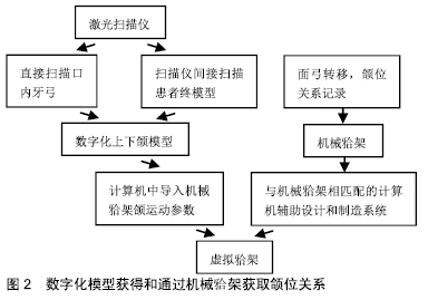
2.1 虚拟架概述与上下颌数字化模型建立 虚拟架即计算机数字化架,是计算机技术与学相结合的产物。在计算机辅助设计过程中应用虚拟架,最大的优点在于可将口颌系统完整的情况转化为精准的实时图像和数据,包括口内和机械架上观察不到的细节,从而实现模拟特征性的下颌运动,并可从任意角度、断层显示且模拟人工牙列的动、静态的咬合接触,并且可以集成动画的运动记录。传统机械架根据其结构和功能及其重现人体口颌结构及运动位置关系的程度不同,可分为简单架、半可调式架和全可调架3种。而虚拟架根据其模拟对象不同可分为2种类型,即可完全调节和数学模拟半可调虚拟架。传统架建立需要颌位关系转移,借助面弓再现上颌与铰链轴关节的位置关系;虚拟架则需要通过数字化的面弓系统实现,过程简言之就是上下颌数字化模型数据、颌位关系数据与虚拟架数据在三维空间中的匹配[5-6]。 Kordass和G?rtner在1999年描述了虚拟架的输入数据编程和调整方法,首先通过扫描牙齿和牙齿表面,或使用3D激光扫描仪(Willytec,慕尼黑,德国)扫描修复体或全口义齿模型的正中关系。该扫描仪将垂直激光束投射到物体表面上,配备有电荷耦合器件的数码相机记录从物体反射的光束并将数字信号传输到电子处理系统,处理后的图像数据存储为数字矩阵亮度值,可供扫描仪软件使用,并可用于屏幕可视化和计算机操作[7]。扫描可以通过2种方式完成:①直接数字化:使用口内扫描仪直接从患者口腔完成,见图2;②间接数字化:在患者终印模后完成的最终模型上获得[5,8]。úRY等[9]使用间接数字工作流程来研究虚拟牙科空间的准确性,对应于匹配的模拟点和虚拟点之间的空间距离数据传输的真实性是(0.55±0.31) mm,认为间接数字方法创建的虚拟牙科空间可以更可靠地用于临床实践中的虚拟咬合分析。 "
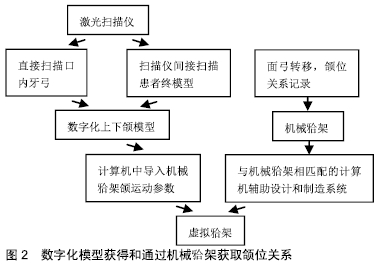
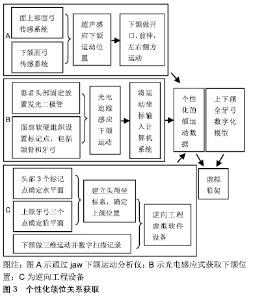
2.2 颌位关系数据与虚拟架匹配 根据颌位关系数据获取的途径和类型可分为由机械架转移的虚拟架和模拟口颌系统的更个性化的虚拟架。 2.2.1 由机械架转移的虚拟架 首先需要转移到传统机械架,再间接将数据传输到虚拟架。根据方式不同又可分为2种。第一,通过实物架向虚拟架的数学模拟转移,通过机械架(Protar 7,KaVo)使用的参数定义不同的颌运动,基于再次将从机械架获得的参数输入到软件。使用时根据需求选择架的类型,录入患者的具体数据,参数包括前伸运动(髁突引导的半径、髁突前伸的最大距离)、后退运动(髁突引导的半径、后退的最大距离)、侧方运动(侧方最大突出、侧方髁导斜度、右侧和左侧的半径、左右水平髁突斜率、侧向位移)、开闭口运动(最大开口度)。在定义运动参数之后,需要进行上下颌叩齿碰撞检测以识别运动约束,这导致上颌和下颌相互滑动。对于碰撞检测,使用基于射线的算法,该算法在预处理步骤中执行。对于咬合检测,选择与机械架中使用的咬合纸厚度相对应的厚度,根据该定义的距离计算咬合点[10]。一般这些架表现为平均值,配准的数学模拟可以紧密复制安装在半可调架中模型的主要运动,不可能获得每个患者的个性化运动路径[11]。第二,机械架到虚拟架直接转移。有几家公司为他们的计算机辅助设计与计算机辅助制造系统定制了虚拟架。通过面弓与机械架结合使用,将上颌弓与3个空间平面中的髁铰链轴线相关联,以获得完全可调节的机械架。首先获取患者的机械架,要求机械面弓适应患者,然后转移到机械架以安装上颌骨模型。随后,根据实验室扫描仪的类型通过机械架插入安装的上颌骨和下颌骨模型(例如在西诺德X5中),用转移组件固定(Ceramill map400功能性扫描仪,阿曼吉尔巴赫)将机械架转移到虚拟架。使用这种做法的公司是阿曼吉尔巴赫、Smart Optics和Zirkonzahn。因此,机械架的选择应该基于实验室扫描仪的类型,其中相应的转移组件将与相同类型的虚拟架相匹配[12],见图2。 2.2.2 模拟口颌系统的更个性化的虚拟架 不需要传统架的参与,通过各类下颌运动分析系统等间接转移患者个性化下颌运动数据到虚拟架空间中。 (1)超声感应式下颌运动分析仪(JawMotionAnalyser?JMA)工具(Zebris,德国):首先通过光学扫描仪获得每个牙齿、全口牙弓和咬合面的数字图像,再使用下颌运动分析系统的传感器系统,检测所有自由度中的旋转和精确位[5,8]。该软件计算并可视化静态和动态咬合碰撞,用于计算机辅助设计系统中咬合面的设计和校正。例如使用下颌运动分析仪系统(JMA-Zebris,Isny/Allg?u,德国)在脸部位置测量下颌运动的幅度时,使用以下方案:①金属弧(由制造商提供)-类似于咬合叉-使用树脂复合物固定到下颌切牙上。仅施加黏合剂、光聚合固化,随后将树脂与金属电弧一起再次光照聚合,在两个阶段中总光聚合时间20 s来固定电弧。②放置金属弧后,固定带有侧面和正面天线的上部面弓。它支撑在左右颞窝上,通过在鼻背区域鼻梁的支撑点和塑料带将上部面弓固定在头部顶部,以防止其移位。固定上部面弓后,使用金属指针连接到下部面弓,通过下弓校准参考点,遵循以下顺序:左髁、右髁、右下眼眶点、上颌切牙中点。③在不使用金属指针(仅用于记录上述点)的情况下,将下方面弓的磁性表面固定在下颌前牙前庭表面的金属弧上,来固定下方面弓。④然后要求参与者依次进行以下颌运动:2个最大开口和2个最大前伸运动以校准装置。校准后,要求参与者执行3个最大开口、3个最大前伸运动、右侧方运动/牙齿咬合/左侧侧方运动(3次)。⑤使用设备本身的WinJaw软件(版本10.6.50)获得下颌运动的幅度,评估以下下颌运动:开口、前伸、左右侧向性运动[13]。 (2)光电感应技术与虚拟面弓转移方法:例如有光电感应技术检测下颌运动的系统,使用电荷耦合器件相机记录位于患者头部上方的发光二极管的发射,并根据这些信号生成图像的光电装置,用于检测固定在面部的标记位置,实时识别标记软硬组织,用于三维重建髁突和下颌运动。受试者直立坐在摄像机前面,被要求进行下颌运动,记录标记的位置,并将坐标输入计算机,并通过在计算机上实现的数学算法转换成三维运动学数据,对头部运动和下颌骨单独运动进行三维数学重建[14]。FANG等[15]使用这样的光学跟踪系统进行下颌骨运动建模,提出了评估下颌动力学的新模型。他们为每例患者设计了一个个性化的固定支架装置,固定在石膏模型和口腔中的相同位置。首先扫描模型,然后指导患者慢慢地进行3种类型(开口/闭口、前伸/后退和侧向偏移)的下颌运动中的1种,每种至少20次,然后将获得的数字数据用于数学建模处理,以重建每个患者的个体动态,用于可视化和基于计算机的分析。 这种下颌运动记录的方法在20世纪90年代就有提出,HAYASHI等[16]使用光度测量法用于6个自由度下颌运动的测量,小型发光二极管作为信号,电荷耦合器件作为光电传感器,下颌骨的位置和方向从测量的所有二极管的位置估计,从而有效地减少了测量误差。最后根据各种精度验证试验,所有牙齿和髁突的静态总体精度被认为在0.19-0.34 mm之间。 也有使用光学扫描和基于逆向工程实现虚拟面弓的方法,通过用参考头加横向水平轴扫描6个点将上颌模型的精确位置传递到虚拟架。使用连接到具有特定软件的个人计算机的光学扫描仪(口内扫描仪)扫描上颌和下颌弓,在患者头部确定3个口外点(颞下颌关节上的2个点和左眼下方的眶下点处的1个点)以产生水平面;然后将咬合纸放置在上颌牙齿上的扁平金属面弓上,确定3个口内点(最高的牙尖点)以产生咬合平面。总共6个点可以创建不同的头颅坐标系,其中患者的头颅坐标系与虚拟架的头颅坐标系一致。因此,逆向工程将上颌骨数字模型转移到虚拟架软件(虚拟架中正中咬合位的上颌模型的虚拟安装)。最后,指示患者在正中咬合位上做开闭口运动并且使用口内扫描从3个不同的方向(右、左、前)执行颊侧扫描(数字咬合记录),以将下颌数字模型定向到正中咬合位的虚拟架上的上颌数字模型(下颌模拟的虚拟安装)[17]。SOLABERRIETA等[18]使用虚拟程序,通过口内扫描仪、数码相机和软件(Agisoft和逆向工程设备)用“虚拟面弓”来对齐口内扫描到3D面部扫描,然后将数字上颌模型定向到虚拟架匹配面部标志,直接将患者口颌系统信息定位转移到虚拟架(虚拟面弓转移)的三维模型,见图3。并在随后的研究中用改进的逆向工程工具得出这种虚拟咬合过程的有效性[19]。该技术提供了患者面部的数据拷贝,可在整个诊断、计划和治疗阶段使用,但缺乏临床应用研究,仍需要进行额外的研究以验证这些有前途的新数字系统的准确性和可重复性。在不用面扫时PETRE等[20]用标准化照片辅助应用于牙科的计算机辅助设计和制造软件程序的虚拟架模块中,通过把数字上颌模型与虚拟架相对于患者平面和髁轴的皮肤标记点的正确对准来完成虚拟面弓转移。 "
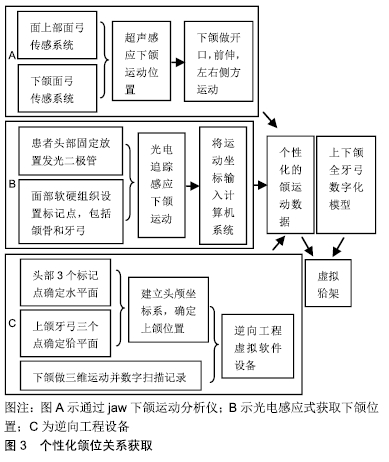
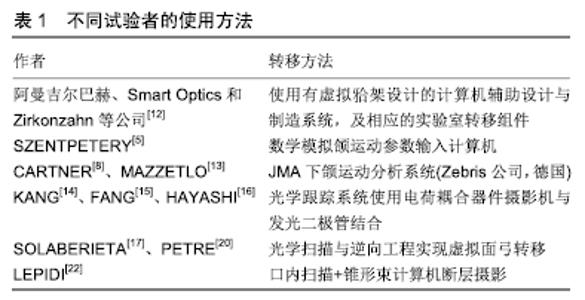
(3)口扫数据和锥形束CT数据匹配:SOLABERRIETA等[17]使用的虚拟面弓技术,需要依赖特定的口内扫描仪,面部扫描仪或其他特定的软件系统,在大多数牙科诊所和实验室都没有配备面部扫描仪和软件,有些复杂牙科病例像是正颌外科正畸种植等需要口颌系统的解剖结构如颌骨、牙列在架上准确地进行模拟是治疗计划制定和执行的先决条件。通过口内扫描获得的数字牙齿图像可以与诸如锥形束CT或立体摄影测量的3D面部图像合并与现有的牙科计算机辅助设计与制造系统兼容以生成虚拟患者模型,这种完整的数字化方法可以更好地诊断、计划治疗和与患者沟通[21]。LEPIDI等[22]通过使用口内扫描和锥形束CT扫描,将数据导出为医学中的数字成像和通信文件,就得到了清晰的上颌弓和虚拟架,扫描视野应该包括上颌骨、眶下点和外耳道。这种技术减少了椅旁时间,它可用于正颌外科手术,包括需要锥形束CT扫描的跨学科治疗,以及需要具有大视野诊断或治疗的头部CT或锥形束CT扫描。上述不同转移方式见表1。 "
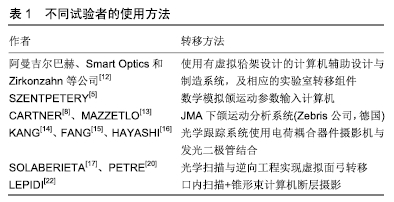

2.3 虚拟架的相关应用研究 随着数字化的不断发展,传统流程正逐渐被完全数字化所取代,通过计算机辅助设计与制造系统和逆向工程工具实现牙科虚拟架的设计,整合不同工具和软件可以实现牙科完全数字工作流程。2002年Kordass和G?rtner推出的虚拟架的基本系统基于采集数据输入后生成下颌运动的动画,并计算咬合接触点,这些咬合点又通过某种类型的代码显示在屏幕上,可以集成动画的运动记录。例如,Dent-CAM?虚拟架(COMP卡沃,DL.kirch))的软件使用3个显示相同运动模式的主窗口:①解释窗口:这显示了动态咬合中的上颌骨允许获得不同寻常的视角,例如在咀嚼期间从闭口时牙齿的咬合面观察;②咬合窗口:显示上下牙齿咬合面上出现的接触点随时间的变化;③截面窗口:这提供了沿着牙弓不同的冠状面,这个工具可以用来分析牙尖的交错程度,以及尖牙的高度和功能角度[8]。最新的软件版本结合了正畸模块,允许创建虚拟设置。该程序还配备了髁突轨迹在矢状面和水平面的表现,这个工具允许观察切牙引导和髁突引导之间的相互关系,以及关节活动性对咬合的影响。在将DentCAM?虚拟架与机械架(Comp.KaVo,DLeutkirch)进行比较时,在侧向移动中获得了大约相同数量的接触,其中8例患者应用了2种架(机械架:90个咬合接触点;虚拟架:92个咬合接触点)。为了评估可靠性,3名操作员在8例患者中测量了2次下颌运动,在动态接触的数量和位置的可视化中发现了良好的对应关系[23]。基于虚拟架的三维再现特点目前的应用主要分为两大块,第一为口颌系统解剖结构虚拟化,静态观察分析用于颌面骨骼牙列的诊断治疗;第二为颌骨动态运动过程虚拟化,动态分析颞下颌关节、咬合等情况。 2.3.1 口颌系统解剖结构虚拟化 正颌手术中诊断分析设计:颅颌面骨骼和牙齿咬合的分析是颅颌面外科手术的关键计划步骤。传统正颌手术计划过程的各个阶段包括临床面部分析、头部测量分析、模型手术和手术模板生成,通常使用安装在架上的模型来计划。准确定位安装在架上的单个石膏模型有助于外科医生进行术前评估,然而这些模型限制了对牙齿表面和牙关系的分析。该过程是费力的,需要取模、石膏模型、咬合记录和面弓转移,它不提供任何有关面部软组织或骨骼的信息。这种传统的计划在安装石膏的现有架分析上引入了许多影响术后结果的不准确之处,它是不准确和不可靠的[24]。 QUAST等[25]对38例患者进行了2次正颌外科手术计划:分别基于石膏模型架和基于计算机的手术计划软件,结果显示咬合不稳定的类型对误差量没有显著影响,三维面弓转移的误差满足临床要求,可以作为传统计划的有利替代方案。同类型案例的对比研究表明,在单颌和双颌正颌虚拟外科手术规划方法中所花费的时间远远少于传统规划[26],比传统方法更可行、更精确、更有效直观,并减少错误和规划时间,提高计划流程的整体绩效[27-29]。 另外在缺乏特定虚拟架软件的诊所,通过口内扫描获得的数字牙齿图像与大视野的诸如锥形束CT结合建立的虚拟患者仍可以应用于复杂的跨学科,如正畸、假体、种植和颞下颌关节疾病的诊断/治疗[30-31],虚拟架系统是记录手术前后动态运动和预测手术结果的有用工具。 提高精确性降低敏感度的操作也在不断尝试,LAM等[32]用2个常规的头部测量图像开发了一种虚拟架,创建用于正颌手术中使用的真实夹板。使用了高精度六脚架,在技术人员的常规计划精确地再现后,缺乏经验的外科医生可以取得良好的效果[7]。而有学者则提出在虚拟架中使用一种校准立体摄影测量的临床技术,在患者处于自然头部位置时转移真实水平面,以避免水平面的解剖差异,显示出良好的可重复性,在1例患者的5次重复测量中,位置差异小于1°和1 mm。 2.3.2 颌骨动态运动过程虚拟化 (1)颞下颌关节运动过程诊断分析:下颌运动分析系统可帮助理解不同临床状况的下颌骨运动学。HUGGER等[33]在2001年第一次分析了下颌运动分析系统的准确性,其目标是为其临床应用建立参数。获得的数据被传输到笛卡尔平面并通过WinJaw软件进行数值分析(ZebrisMedical GmbH,Isny,Germany),结果显示出约0.1 mm的良好精度,作者建议使用这种超声测量系统来测量牙科实践中的下颌运动。同样的报道指出了使用具有6个自由度的颌骨运动跟踪设备分析颌骨运动的重要性,通过测量颌运动过程中的髁突平移和旋转来评估CMS-JAW设备获得的髁突转动范围,在复制的空间中未观察到明显的扭曲,CMS-JAW为临床应用提供了可接受的测量精度[34]。例如,颞下颌关节紊乱的特征包括颞下颌关节、耳前区和/或咀嚼肌在下颌功能触诊、运动期间引发的疼痛、下颌运动轨迹的偏差、伴关节杂音等。不仅有下颌运动学的这种局限性,健康受试者和颞下颌关节紊乱患者的咬合力平均咬合负荷分布和咬合力中心的位置之间出现了最显著的差异[35]。KIJAK等[36]使用超声下颌运动分析系统评估具有这种临床症状的个体,发现与对照个体相比,口腔张开模式也存在差异。在比较传统使用数字游标卡尺和3D超声下颌运动分析系统测量下颌边缘运动时,这2种方法都有效,但是超声波系统允许其他类型的指标分析,例如下颌运动轨迹和速度。临床应用中需要记录颌骨运动分析数据和对患者的功能监测,以作为诊断和治疗的监视工具[37]。 下颌运动分析系统的另一个临床应用是确定髁突的位置和髁突倾斜的个性化,以便架安装。有研究指出在记录水平髁斜角度上,下颌运动分析系统比传统方法记录重复性更高,结果是可靠和有效的[38]。一些国内学者用虚拟架和锥形束CT扫描结合建立数字化三维模型,模拟下颌开口前伸,侧方运动时,观察推算髁突三维运动轨迹,并进一步推算出髁突功能面的三维运动形态,使用下颌运动记录系统将数字化下颌运动记录与肌电图相结合,初步探讨下颌运动与咀嚼肌之间的关系和机制[39-40]。国外有研究使用3D光学扫描仪和目标跟踪系统描绘实际的下颌运动,通过合并锥形束CT数据三维再现下颌骨包括颞下颌关节区域的运动,来诊断和治疗颞下颌关节疾病[41]。 (2)牙齿咬合面分析调整:咬合的评估在口腔修复学和修复牙科中是重要的,因为要恢复的牙齿咬合面必须是患者口颌系统的功能单元。具体而言,牙尖、窝沟和边缘嵴的形态应呈牙尖交错位,在非正中颌运动诸如咀嚼之类的功能活动中在合适舒服的位置,修复的牙齿不应干扰咀嚼、言语和吞咽等下颌功能,也不应在牙尖交错位、颌骨非正中位置或运动过程中向支持组织或颞下颌关节传递过大的力。虚拟架的功能被用来评估修复和修复后的牙齿咬合状态,以得到颌骨运动过程中自由功能空间内更准确的咬合关系及更舒适的铰链轴关系。 KIM等[42]使用台式扫描仪(Identica hybrid)将制造的模型转移到虚拟环境中,利用面扫和目标跟踪,转换得到牙科模型扫描数据的视频剪辑,可实时显示下颌运动。咬合接触信息由计算机辅助设计软件生成,用重建的非正中运动进行动态和静态咬合分析,可以实现患者在虚拟环境中的咬合动力学分析。KALMAN等[43]用开发的一个牙科软件应用程序虚拟面弓App与传统面弓方式转移对比,得出数字化虚拟面弓提高了安装效率、咬合精度、咬合准确性,降低了成本,2种方法的实验室时间和总时间差异有显著性意义(P < 0.05),认为虚拟面弓为模型上架提供了新的替代方案,并为临床医生-技术人员通信提供了另一种工具。HSU等[44]用Artex-CR机械架与虚拟架进行真实性和精确性比较,最终结果显示两者差异无显著性意义,可以将患者的动态咬合信息转移到虚拟架,进行临床分析和修复体的咬合调整。 同样,其他研究也比较了传统方法与虚拟咬合之间的最大接触数,数字化虚拟模型可以精确再现用机械架获得的咬合接触数[45]。在咬合不稳定模型的体外比较研究中,在虚拟模型中,磨牙和前磨牙区域显示出相对准确的咬合接触面积[46]。SOLABERRIETA等[47]通过使用3个当前的逆向工程软件在进一步对虚拟咬合关系记录与传统方式比较后发现,虚拟咬合记录过程的平均偏差仅为0.069?mm,并且所有咬合点的标准差平均值仅为 0.011?mm,与机械架0.265?6 mm的平均差相较而言,更接近真实的咬合情况,虚拟咬合程序提供的准确性大于传统的物理咬合记录。虚拟架成为对真实患者的咬合进行全面分析的精确工具[48],但是目前体外研究较多,仍需要进一步的临床研究来确定其在口腔修复治疗中的准确性。 "

| [1] QUINLAN P. Articulators, face bows and interocclusal records. J Ir Dent Assoc. 2016;62(2):102-104. [2] OANCEA L, STEGAROIU R, CRISTACHE CM. The influence of temporomandibular joint movement parameters on dental morphology. Ann Anat. 2018;218(7):49-58. [3] WANG M, MEHTA N.A possible biomechanical role of occlusal cusp-fossa contact relationships.J Oral Rehabil. 2013;40(1):69-79. [4] HSU MR, DRISCOLL CF, ROMBERG E, et al. Accuracy of dynamic virtual articulation: trueness and precision. J Prosthodont.2019;28(4): 436-443. [5] KORALAKUNTE PR, ALJANAKH M.The role of virtual articulator in prosthetic and restorative dentistry.J Clin Diagn Res. 2014;8(7): ZE25-28. [6] 刘峰,师晓蕊.面弓架应用基本技术[M].北京:人民卫生出版社, 2018. [7] GHANAI S, MARMULLA R, WIECHNIK J, et al. Computer-assisted three-dimensional surgical planning: 3D virtual articulator: technical note. Int J Oral Maxillofac Surg. 2010;39(1):75-82. [8] MAESTRE-FERRÍN L, ROMERO-MILLÁN J, PEÑARROCHA-OLTRA D, et al. Virtual articulator for the analysis of dental occlusion: an update. Med Oral Patol Oral Cir Bucal. 2012;17(1):e160-163. [9] ÚRY E, FORNAI C, WEBER GW. Accuracy of transferring analog dental casts to a virtual articulator. J Prosthet Dent. 2019. pii: S0022-3913(19)30073-3. [10] ENCISO R, MEMON A, MAH J. Three-dimensional visualization of the craniofacial patient: volume segmentation, data integration and animation. Orthod Craniofac Res. 2003;6 Suppl 1:66-71; discussion 179-182. [11] STAVNESS IK, HANNAM AG, TOBIAS DL, et al.Simulation of dental collisions and occlusal dynamics in the virtual environment. J Oral Rehabil. 2016;43(4):269-278. [12] ALGHAZZAWI TF.Advancements in CAD/CAM technology: Options for practical implementation. J Prosthodont Res. 2016;60(2):72-84. [13] MAZZETTO MO, ANACLETO MA, RODRIGUES CA, et al. Comparison of mandibular movements in TMD by means of a 3D ultrasonic system and digital caliper rule. Cranio. 2017; 35(1):46-51. [14] KANG DW, MONGINI F, ROSSI F, et al. A system for the study of jaw movements. Cranio. 1993;11(1):63-67. [15] FANG JJ, KUO TH. Modelling of mandibular movement. Comput Biol Med. 2008;38:1152-1162. [16] HAYASHI T, KUROKAWA M, MIYAKAWA M, et al. A high-resolution line sensor-based photostereometric system for measuring jaw movements in 6 degrees of freedom. Front Med Biol Eng.1994;6(3): 171-186. [17] SOLABERRIETA E, OTEGI JR, MÍNGUEZ R, et al.Improved digital transfer of the maxillary cast to a virtual articulator. J Prosthet Dent. 2014;112(4):921-924. [18] SOLABERRIETA E, GARMENDIA A, MINGUEZ R, et al. Virtual facebow technique. J Prosthet Dent. 2015;114(6):751-755. [19] SOLABERRIETA E, ARIAS A, BRIZUELA A, et al. Determining the requirements, section quantity, and dimension of the virtual occlusal record. J Prosthet Dent. 2016;115(1):52-56. [20] PETRE A, DRAFTA S, STEFANESCU C, et al. Virtual facebow technique using standardized background images. J Prosthet Dent. 2019;121(5):724-728. [21] MANGANO C, LUONGO F, MIGLIARIO M, et al. Combining intraoral scans, cone beam computed tomography and face scans: the virtual patient. J Craniofac Surg. 2018;29(8): 2241-2246. [22] LEPIDI L, CHEN Z, RAVIDA A, et al. A full-digital technique to mount a maxillary arch scan on a virtual articulator. J Prosthodont. 2019;28(3): 335-338. [23] KORDASS B, GÄRTNER C, SÖHNEL A, et al. The virtual articulator in dentistry: concept and development. Dent Clin North Am. 2002;46: 493-506. [24] MCCORMICK SU, DREW SJ. Virtual model surgery for efficient planning and surgical performance. J Oral Maxillofac Surg. 2011;69(3): 638-644. [25] QUAST A, SANTANDER P, WITT D, et al.Traditional face-bow transfer versus three-dimensional virtual reconstruction in orthognathic surgery. Int J Oral Maxillofac Surg. 2019;48(3):347-354. [26] RITTO FG, SCHMITT ARM, PIMENTEL T, et al.Comparison of the accuracy of maxillary position between conventional model surgery and virtual surgical planning. Int J Oral Maxillofac Surg. 2018;47(2): 160-166. [27] ZARAGOZA-SIQUEIROS J, MEDELLIN-CASTILLO HI, DE LA GARZA-CAMARGO H, et al.An integrated haptic-enabled virtual reality system for orthognathic surgery planning.Comput Methods Biomech Biomed Engin. 2019;22(5):499-517. [28] CHIN SJ, WILDE F, NEUHAUS M, et al.Accuracy of virtual surgical planning of orthognathic surgery with aid of CAD/CAM fabricated surgical splint-A novel 3D analyzing algorithm.J Craniomaxillofac Surg. 2017;45(12):1962-1970. [29] HANAFY M, AKOUSH Y, ABOU-ELFETOUH A, et al. Precision of orthognathic digital plan transfer using patient-specific cutting guides and osteosynthesis versus mixed analogue-digitally planned surgery: a randomized controlled clinical trial. Int J Oral Maxillofac Surg. 2019. pii: S0901-5027(19)31217-2. [30] RIOS HF, BORGNAKKE WS, BENAVIDES E. The use of cone-beam computed tomography in management of patients requiring dental implants: an american academy of periodontology best evidence review. J Periodontol. 2017; 88(10):946-959. [31] ZIZELMANN C, HAMMER B, GELLRICH NC, et al. An evaluation of face-bow transfer for the planning of orthognathic surgery. J Oral Maxillofac Surg. 2012;70:1944-1950. [32] LAM WYH, HSUNG RTC, CHOI WWS, et al.A clinical technique for virtual articulator mounting with natural head position by using calibrated stereophotogrammetry. J Prosthet Dent. 2018;119(6): 902-908. [33] HUGGER A, BÖLÖNI E, BERNTIEN U, et al. Accuracy of an ultrasonic measurement system for jaw movement recording. J Dent Res. 2001; 80:1226. [34] UCHIDA T, SAKAI J, OKAMOTO Y, et al. Studies evaluating measurement accuracy of CMS-JAW, a jaw motion tracking device with six degrees of freedom using an ultrasonic recording system.Nihon Hotetsu Shika Gakkai Zasshi. 2008;52(3):350-359. [35] FERRATO G, FALISI G, IERARDO G, et al. Digital evaluation of occlusal forces: comparison between healthy subjects and TMD patients. Annali di Stomatologia. 2017;VIII(2):79-88. [36] KIJAK E, LIETZ-KIJAK D, FRĄCZAK B, et al. Assessment of the TMJ dysfunction using the computerized facebow analysis of selected parameters. Biomed Res Int. 2015; 508069-1-508069-9. [37] AHLERS MO, BERNHARDT O, JAKSTAT HA, et al. Motion analysis of the mandible: guidelines for standardized analysis of computer-assisted recording of condylar movements.Int J Comput Dent. 2015;18(3):201-223. [38] RATZMANN A, MUNDT T, SCHWAHN C, et al. Comparative clinical investigation of horizontal condylar inclination using the JMA electronic recording system and a protrusive wax record for setting articulators. Int J Comput Dent. 2007;10(3): 265-284. [39] 黄超,许向亮,孙玉春,等.下颌髁突功能面三维运动轨迹的初步推算和模拟[J].中华口腔医学杂志,2018,53(10):669-673. [40] 王晶,陈俊鹏,王洋,等.数字化下颌运动记录及咀嚼肌肌电图在下颌骨肿瘤患者口颌功能评价中的应用[J].北京大学学报(医学版), 2019,51(3): 571-578. [41] KWON JH, IM S, CHANG M, et al. A digital approach to dynamic jaw tracking using a target tracking system and a structured-light three-dimensional scanner. J Prosthodont Res. 2019;63(1):115-119. [42] KIM JE, PARK JH, MOON HS, et al.Complete assessment of occlusal dynamics and establishment of a digital workflow by using target tracking with a three-dimensional facial scanner.J Prosthodont Res. 2019;63(1):120-124. [43] KALMAN L, CHRAPKA J, JOSEPH Y. Digitizing the Facebow: A Clinician/Technician Communication Tool.Int J Prosthodont. 2016; 29(1):35-37. [44] HSU MR, DRISCOLL CF, ROMBERG E, et al. Accuracy of Dynamic Virtual Articulation: Trueness and Precision.J Prosthodont. 2019;28(4):436-443. [45] DELONG R, KNORR S, ANDERSON GC, et al.Accuracy of contacts calculated from 3D images of occlusal surfaces.J Dent. 2007;35(6): 528-534. [46] LEE H, CHA J, CHUN YS, et al.Kim M.Comparison of the occlusal contact area of virtual models and actual models: a comparative in vitro study on Class I and Class II malocclusion models. BMC Oral Health. 2018; 18(1):109. [47] SOLABERRIETA E, OTEGI JR, GOICOECHEA N, et al. Comparison of a conventional and virtual occlusal record. J Prosthet Dent. 2015; 114(1):92-97. [48] SHETTY S. Virtual articulators and virtual facebow transfers: Digital prosthodontics.J Indian Prosthodont Soc. 2015;15(4): 291. [49] BHAMBHANI R, BHATTACHARYA J, SEN SK.Digitization and its futuristic approach in prosthodontics.J Indian Prosthodont Soc. 2013; 13(3):165-174. [50] HASSAN B, GIMENEZ GONZALEZ B, TAHMASEB A, et al. A digital approach integrating facial scanning in a CAD-CAM workflow for complete-mouth implant-supported rehabilitation of patients with edentulism: A pilot clinical study. J Prosthet Dent. 2017;117:486-492. |
| [1] | Li Huo, Wang Peng, Gao Jianming, Jiang Haoran, Lu Xiaobo, Peng Jiang. Relationship between revascularization and internal microstructure changes in osteonecrosis of the femoral head [J]. Chinese Journal of Tissue Engineering Research, 2022, 26(9): 1323-1328. |
| [2] | Pan Baoshun, Fang Zhen, Gao Mingjie, Fang Guiming, Chen Jinshui. Design for posterior atlantoaxial internal fixation system with fusion cage based on imaging data [J]. Chinese Journal of Tissue Engineering Research, 2022, 26(9): 1372-1376. |
| [3] | Baibujiafu·Yelisi, Renaguli·Maihemuti, Aizimaitijiang·Saiyiti, Wang Junxiang, Nijiati·Tuerxun. Stress analysis of maxillary central incisor crown implant restoration in different occlusal modes [J]. Chinese Journal of Tissue Engineering Research, 2022, 26(4): 567-572. |
| [4] | Cao Sheng, Kong Lingwei, Xu Kun, Sun Zhijie. Evaluation value of cervical sagittal plane sequence parameters on pain, cervical function and clinical efficacy in patients with cervical spondylotic myelopathy [J]. Chinese Journal of Tissue Engineering Research, 2022, 26(3): 419-424. |
| [5] | Zhang Jian, Lin Jianping, Zhou Gang, Fang Yehan, Wang Benchao, Wu Yongchang. Semi-quantitative MRI evaluation of cartilage degeneration in early knee osteoarthritis [J]. Chinese Journal of Tissue Engineering Research, 2022, 26(3): 425-429. |
| [6] | Wu Yafei, Zhu Liang, Ren Qiujian, Li Daen, Li Dadi, Gao Xuren, Guo Kaijin. Relationship between glenoid version angle and degenerative rotator cuff full-thickness tear: matched case control trial [J]. Chinese Journal of Tissue Engineering Research, 2022, 26(3): 435-439. |
| [7] | Wei Haoxin, Wang Caiping, Deng Qian, Song Yan, Wang Xiaowen, Wang Jinwu. Design and clinical application of personalized cervical spine correction pillow with three-dimensional printing [J]. Chinese Journal of Tissue Engineering Research, 2021, 25(36): 5741-5746. |
| [8] | Wang Sizhe, Gao Haiyan, Lan Xiaoquan, Wang Pan, Huang Haoran, Wang Jinyu, Ma Jianlin. A short-term evaluation of three-dimensional printed guide plate assisted hollow screw in the treatment of non-displaced femoral neck fracture [J]. Chinese Journal of Tissue Engineering Research, 2021, 25(36): 5753-5758. |
| [9] | Wu Chao, Gao Mingjie, Wang Jianzhong, Zhang Yunfeng, Yu Jinghong, Cai Yongqiang, Wang Haiyan, He Yujie, Tong Ling, Li Jiawei, Gao Shang, Wang Xing, Wu Min, Li Zhijun, Li Xiaohe. Finite element analysis of stress and displacement of Lenke 3 adolescent idiopathic scoliosis thoracolumbar spine [J]. Chinese Journal of Tissue Engineering Research, 2021, 25(33): 5273-5280. |
| [10] | Hu Zhe, Zhao Haiyan, Zhang Shaojie, Cai Yongqiang, Wang Xing, Qu Xingyue, Ma Yuan, Li Zhijun. Evaluation of regional characteristics and structural, functional stability of C2-C7 articular process based on Micro-CT observation [J]. Chinese Journal of Tissue Engineering Research, 2021, 25(33): 5356-5361. |
| [11] | Xie Jiang, Dai Jie, Li Hui, Zhu Xu. Biomechanical analysis of sagittal balance restoration of ankylosing kyphosis based on pelvic sagittal parameters [J]. Chinese Journal of Tissue Engineering Research, 2021, 25(30): 4762-4766. |
| [12] | Zhang Xinming, Liu Zhihua, Zhang Xinmin, Shen Yankui, Wang Chunli. Establishment of a total cervical spine model and characteristics of traction force and traction angles under different traction orientations [J]. Chinese Journal of Tissue Engineering Research, 2021, 25(30): 4805-4811. |
| [13] | Zhong Ruixin, Gao Haiyan, Huang Haoran, Teng Xueren, Dai Shiyou. Anatomical features of anterior cruciate ligament on MRI in children, adolescents and adults [J]. Chinese Journal of Tissue Engineering Research, 2021, 25(30): 4812-4817. |
| [14] | Zhou Yuanbo, Huang Wenliang, Wang Jindong. Imaging analysis of the correlation between tibial tuberosity-trochlea groove distance and femoral trochlea morphology [J]. Chinese Journal of Tissue Engineering Research, 2021, 25(27): 4390-4394. |
| [15] | Shu Qihang, Liao Yijia, Xue Jingbo, Yan Yiguo, Wang Cheng. Three-dimensional finite element analysis of a new three-dimensional printed porous fusion cage for cervical vertebra [J]. Chinese Journal of Tissue Engineering Research, 2021, 25(24): 3810-3815. |
| Viewed | ||||||
|
Full text |
|
|||||
|
Abstract |
|
|||||